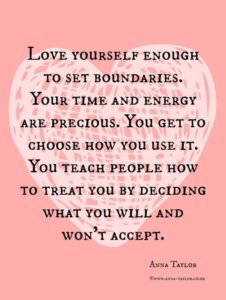by: Jill Siegel, MHC Development Committee
 Having healthy boundaries means knowing and understanding what your limits are so that you feel at peace and contentment in your day to day life. Here are 5 ways to help you set healthy boundaries:
Having healthy boundaries means knowing and understanding what your limits are so that you feel at peace and contentment in your day to day life. Here are 5 ways to help you set healthy boundaries:
- 1. It’s important to know your cues, triggers and the situations and feelings that identify your physical, emotional, mental and spiritual limits. These feelings help us know what our limits are and help us set healthy boundaries for mental wellness.
2. Know what you can tolerate and accept, and what makes you feel good and what makes you feel bad. Tune into these feelings and take note of them, write them down if you need to so that you can keep track of them. Often we push down, or push aside things, situations and feelings that make us feel bad. By writing these triggers/cues down, they will be out in the open so that you can use them to be aware of your red flags. This is how you can start to practice self awareness and begin to set boundaries. Name these limits to yourself first so that you can let others know what your limits/boundaries are.
3. Give yourself permission to do this, to share with others what your boundaries are, knowing in your heart that setting boundaries is a sign of creating a space for self respect for yourself and with others.
4. Be direct and honest about your boundaries. In a gentle, yet direct way let other people know what feels good, and what doesn’t feel good, what is bothersome to you, what creates stress or anxiety for you. Through honestly communicating this to people you work with, live with or take care of, or are in a relationship with, you set the space and the stage for a healthy environment for your own mental wellness and a place for you to thrive.
5. Put yourself first, or in other words – always put the oxygen mask on yourself first. You are no good to yourself or to others until you take care of yourself first and make yourself a priority. Once you start taking a deep breath of that oxygen for yourself first, you will be in a more balanced, healthier mindset to live your best life and to be at your best for the other people in your life.
I know from my own experiences in life that taking care of yourself while juggling many other priorities and responsibilities can be hard to do. Personally, when the stress in my life and anxiety overwhelmed me and became too much for me to handle, it was too late, I made the mistake of not setting healthy boundaries and then it was too late, causing severe insomnia. I couldn’t sleep for six months, and I spiraled into an anxiety driven depression. It was horrible, something I wouldn’t want anyone to ever have to experience. If I had known then what I know now, that there are simple things you can do to set boundaries and make yourself and time for self care happen easily with little to no cost, I could have avoided the severity of anxiety and depression I experienced. I don’t want this to happen to you or to anyone, so I’d like to share the following suggestions that work for me, where I create a space and the time for self preservation in my life. I hope you find these suggestions helpful:
- ✨Nature – walk, hike, run or just sit on a park bench or go to the beach or a lake, as there is almost nothing more soothing and healing than being by the water. The vitamin D from the sunshine and nature itself will perk you and your mood up and the peaceful beauty of nature will help reset your mind.
✨ Ask for help when you need it. Take off the Superwomen or Superman cape. It’s okay to be vulnerable and to let others help you and to make things easier for you or just be there to listen. Share with them what you’re feeling, and know that it’s okay to not be okay and to say that you’re overwhelmed or stressed or experiencing anxiety or feeling depressed. By letting others who you trust know how you’re feeling you give them the opportunity to help you. Letting yourself receive help is one of the best ways you can welcome self care into your life.
✨Create a physical space for healthy boundaries by creating your own private oasis or sanctuary in your home or apartment. This can be a repurposed closet or a space in a basement or an attic, see what you can do to make it a calming space just for you. Place oversized cushions on the floor, hang string lights, and make a teepee tent from cotton canvas, or just build your own “fort” in a corner. Even a garage can serve as your self-care space if you spruce it up and create a cozy ambiance.
✨If music brings you peace and makes you feel good, listen to music, if meditating or doing yoga calms you, do it. There are amazing yoga and meditation videos available for free on YouTube, as are relaxing sleep stories and podcasts. Other easy, inexpensive calming outlets are coloring, painting, doing crafty/artsy projects that you enjoy doing.
✨Take a break from work, even if you think you can’t, trust me – you can. Take a day or two off if you need it. There is a reason for the term “mental health day” – the reason is because the need for them is real.
✨Lastly, know that the time you are in right now, perhaps a difficult time you may be experiencing is temporary, and that in time, it will get better. Taking time for yourself for an hour here or there in nature or in your sanctuary space or by taking a mental health day off from work can help you weather the good and bad days, weeks and months. Always remember that it will pass and that in the meantime there are these ? simple and inexpensive ways to make your journey easier.
To learn more about Jill and to show your support of her fundraiser for #31DaysofWellness, visit: https://mhconn.networkforgood.com/projects/130268-jill-siegel-s-fundraising-page-for-mental-health-connecticut

